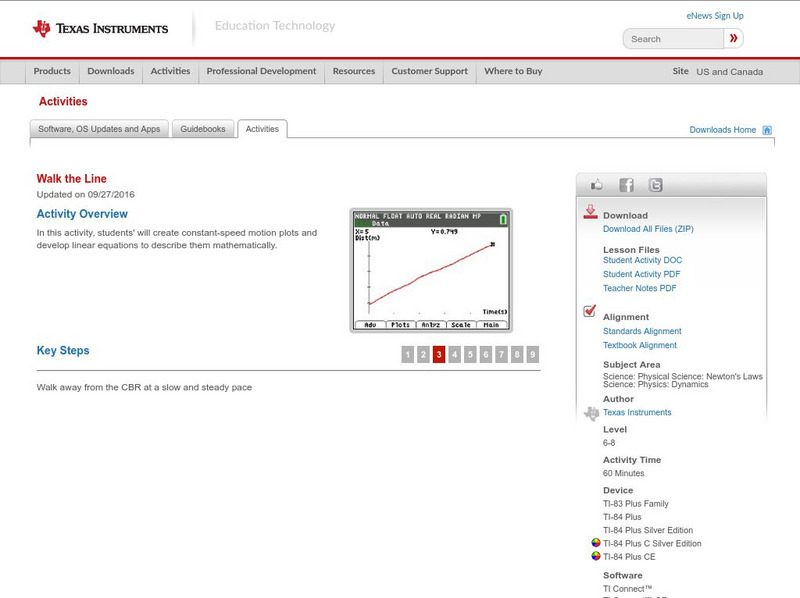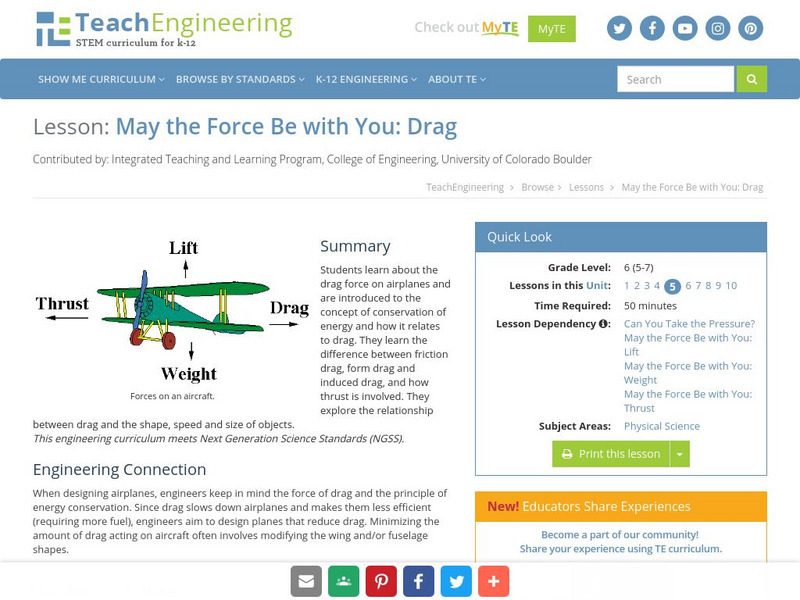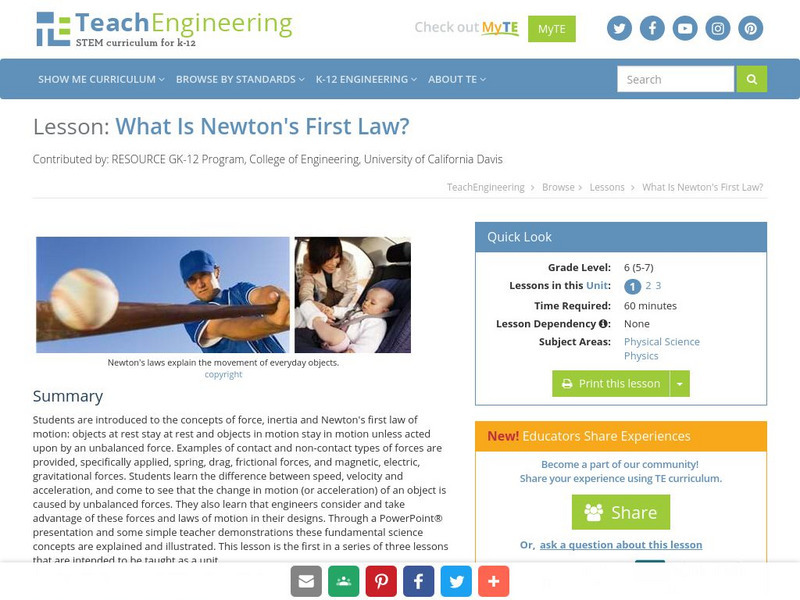Hi, what do you want to do?
Texas Instruments
Texas Instruments: Walk the Line
In this activity, students will create constant-speed motion plots and develop linear equations to describe them mathematically.
Physics Aviary
Physics Aviary: Rolling Distance Lab
In this lab, students will be able to change the radius and the linear speed of a wheel. They can then see how each of these variables affects the angular speed. Students can also look at the relationship between angular distance and...
Physics Aviary
Physics Aviary: Practice Problems: Oh Snap
Students must determine speed and rpm of a object on a string at the moment when the string snaps that is holding the ball in a circular path.
Physics Aviary
Physics Aviary: Practice Problems: Car on a Turn Problem
Students must determine the force of friction on a car on a turn and the maximum speed the car could navigate a turn.
Physics Aviary
Physics Aviary: Practice Problems: Corner Kick
Students must determine the 3 components of the initial velocity of a soccer ball on a corner kick. Students will see the displacement of the ball in all three dimensions as well as the time the ball is in the air. Students must also...
Physics Aviary
Physics Aviary: Drone Delivery Challenge
Land as many objects as close to the target as possible. More points will be earned if the height is high and the speed is fast.
Physics Classroom
The Physics Classroom: Newtons Laws: Rocket Sledder Interactive
Experience the effect of friction, air resistance, and applied force upon a sledder. The speed, acceleration, and force values are displayed as the sled moves. Learners can vary the mass of the sledder and the size of the parachute...
NASA
Nasa: Beginner's Guide to Aerodynamics
Includes exhaustive information and a wealth of activities pertaining to aerodynamics and the physics of flight.
Other
Einstein Archives Online
Online access to portions of Einstein's original papers and manuscripts.
TeachEngineering
Teach Engineering: May the Force Be With You: Drag
This instructional activity explores the drag force on airplanes. The students will be introduced to the concept of conservation of energy and how it relates to drag. Students will explore the relationship between drag and the shape,...
Physics Aviary
Physics Aviary: Practice Problems: Drone Delivery Problem
Students must determine where a drone should be when it releases its package so that the object lands on the target.
Khan Academy
Khan Academy: What Is Acceleration?
Provides definitions, examples, and formulas for acceleration.
CK-12 Foundation
Ck 12: Episd: Position Time Graphs
[Free Registration/Login may be required to access all resource tools.] Understand how to evaluate data presented in graphs based on speed and velocity calculations.
OpenStax
Open Stax: Physics: Centripetal Force
In the following interactive students will begin to calculate coefficient of friction on a car tire. They will also calculate ideal speed and angle of a car on a turn.
University of Colorado
University of Colorado: Ph Et Interactive Simulations: Pendulum Lab
Manipulate the mass of a weight and the length of string in this interactive pendulum simulation. Change the speed, friction, and gravity to make the pendulum swing change as measurements are displayed on the screen. Younger students can...
PBS
Pbs Learning Media: Einstein: How Smart Was He?
This essay from the NOVA Web site explores the impact Einstein made on physics and most everything we know about the cosmos.
Science Buddies
Science Buddies: Time Is Money
By applying principles of industrial engineering and time management, you will learn how you can speed through your chores and still have time to kick back and relax. You will also learn that time-efficiency is not the only factor...
Physics Classroom
The Physics Classroom: The Nature of a Wave
A very good introduction to the world of waves. Waves and wavelike motion, what is a wave, and categories of waves are the topics examined in this site. Many links to other wave sites.
TED Talks
Ted: Ted Ed: The Fundamentals of Space Time: Part 2
In this second installment of a three-part series on space-time, CERN scientists Andrew Pontzen and Tom Whyntie use a space-time diagram to analyze the sometimes confounding motion of light. [4:50]
TeachEngineering
Teach Engineering: What Is Newton's First Law?
Students are introduced to the concepts of force, inertia, and Newton's first law of motion: objects at rest stay at rest and objects in motion stay in motion unless acted upon by an unbalanced force.This instructional activity is the...
Better Lesson
Better Lesson: Falling Objects
Students will determine if objects fall at the same speed by testing a variety of objects as they let them fall from above. They will learn that gravity is the force that is pulling on the object. Included in this lesson is a video about...
TryEngineering
Try Engineering: Measuring the Wind
Young scholars explore the design of anemometers and how they are used in measuring the speed of wind. Working in teams of "engineers", they will design, build, and evaluate the effectiveness of their own anemometers, presenting their...
CK-12 Foundation
Ck 12 Exploration Series: Simulations: Physics: Archery
[Free Registration/Login Required] Watch this animation as an archer shoots at a target on an angle, and its horizontal and vertical paths and its velocity are explained. An interactive follows where you can manipulate the archer's...
PBS
Pbs Learning Media: Energy in a Roller Coaster Ride
This interactive roller coaster ride produced for Teacher's Domain illustrates the relationship between potential and kinetic energy. As the coaster cars go up and down the hills and around the loop of the track, a pie chart shows...
Other popular searches
- Speed and Motion
- Forces and Motion Speed
- Motion Speed and Velocity
- Motion Speed and Distance
- Motion, Speed and Distance
- Motion and Speed Labs
- Speed and Motion Graphs
- Motion and Speed Lessons
- Motion and Speed Powerpoints

















